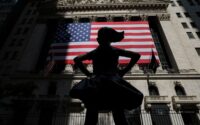The Federal Reserve should not “stall” on raising its benchmark rates until they are above 5%, said St. Louis Fed President James Bullard, on Wednesday.
“I like the front-loading story,” Bullard said in an interview with the Wall Street Journal that was streamed live . The Fed should move as rapidly as it can to get its policy rate over 5% and then it can react to the data, he said.
Bullard noted that, in December, Fed officials projected getting the benchmark rates up to a range of 5%-5.25% this year.
“Why not go to where we’re supposed to go. Why stall?” Bullard asked.
Several of Bullard’s colleagues on the Fed’s interest-rate committee have expressed a preference to slow the pace of rate hikes to a 25 basis point move at their meeting on Jan. 31- Feb. 1. They argue that a slower pace will allow the Fed to see how the tightening is impacting the economy.
Last year the Fed was very aggressive, pushing rates up from close to zero. The Fed raised rates in four super-sized 75 basis point moves before slowing the pace in December to a 50 basis point move that put the benchmark rate in the range of 4.25% – 4.5%.
Bullard said the Fed’s benchmark rate was still not above the level that would put downward pressure on inflation.
In the interview, Bullard said his own preference would be for the Fed to raise its benchmark rate to a range of 5.25%-5.5% this year, which is slightly higher than the consensus. He said some of the increase was insurance to make sure inflation moves lower.
The St. Louis Fed president, who is not a voting member of the Fed’s interest-rate committee this year, said he doesn’t think inflation will recede as fast as the market appears to be projecting.
The global economic outlook has improved in recent weeks, he noted, with recession fears ebbing in Europe and China reopening its economy. This could put renewed pressure on global commodity markets and upward pressure on inflation, he said.
Bullard said it looks more likely that the U.S. economy can avoid a recession.
The prospects of a soft-landing “have improved markedly,” he said. The biggest risk to a soft landing would be a resurgence of inflation, he noted.
U.S. stocks
DJIA,
SPX,
were higher on Wednesday after soft producer inflation, while the yield on the 10-year Treasury note
TMUBMUSD10Y,
fell to 3.39%.


